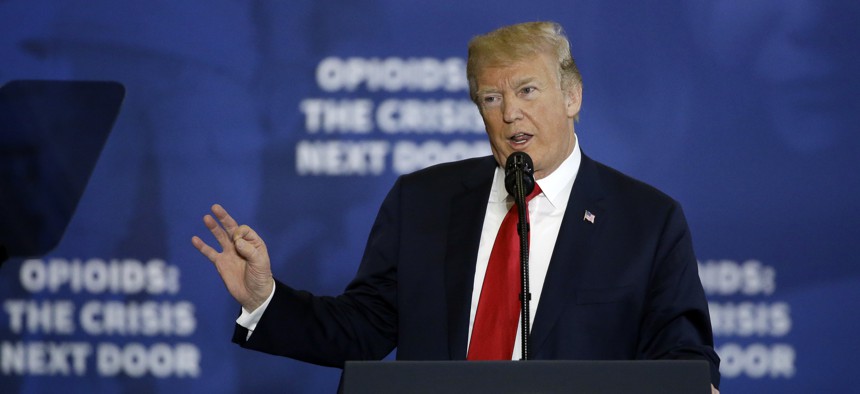Trump’s Opioid Crisis Looks Similar, Yet Altogether Different From State and Local Experience

President Donald Trump speaks about his plan to combat opioid drug addiction at Manchester Community College, Monday, March 19, 2018, in Manchester, N.H. Elise Amendola / AP Photo
The president’s speech in New Hampshire had a mix of bipartisan solutions, along with highly political ideas and rhetoric that could destroy broad support for his initiative.
The vision of the opioid crisis that President Trump presented in New Hampshire on Monday sounded both similar and altogether different from how the crisis has been presented by state and local officials.
The president’s speech floated a range of ideas with strong bipartisan support, like nationalizing prescription drug monitoring programs and making naloxone, a drug that can save the lives of those who have overdosed on opioids, more available to first responders. The president pledged “6 billion additional dollars, going through right now, in new funding in 2018 and 2019 to combat the opioid crisis.”
However, the speech also included direct attacks on Democrats, who he blamed for blocking the construction of a southern border wall and immigration reform.
While the president’s speech did provide for compassionate ideas, Trump also used the word “tough,” or some version of it, 19 times. Being tough included confronting “sanctuary cities” that Trump claimed “release illegal immigrants and drug dealers, traffickers, and gang members back into our communities.” He also proposed expanding the death penalty for those involved in the drug trade.
A number of Trump’s political attacks and proposals have been rejected by experts, Congress and a large portion of the electorate.
“We're going to solve it with brains, we're going to solve it with resolve and we're going to solve it with toughness,” Trump said. “Because toughness is the thing that they most fear. That's what they most fear.”
While the president presented a vision of us versus them, state and local officials have focused on people in their community that are in crisis.
Take Dayton, Ohio, for instance.
Route Fifty spoke with Dayton Mayor Nan Whaley at SXSW in Austin, Texas last week. Her city leads the nation in accidental overdose deaths.
“That’s a figure I don’t want to be leading in,” Whaley said. “It has affected every part of our community, and everyone in our community knows someone who has struggled with addiction, or has died. I think that has been very tough, obviously, for our families and communities.”
In our interview, there was only one actor Whaley spoke about getting tough on: drug manufacturers. Dayton was the fourth city to sue the “manufacturers, the distributors and some of the doctors that were culpable,” in Whaley’s eyes, for the epidemic. According to Whaley, more than 400 local jurisdictions are now a part of that suit.
Whaley hopes it is settled quickly in a manner that brings funding to the crisis.
“You know, we want to be very aggressive about it, we want them to be held accountable, because they created quite a mess in our communities, and they should pay to clean it up and not just the taxpayers,” Whaley said.
In his speech, Trump said the “Department of Justice is looking very seriously into bringing major litigation against some of these drug companies” at the federal level.
The discussion from state and local leaders has been focused much more on the lack of funds for prevention programs than the president’s speech.
Oregon Gov. Kate Brown and Maryland Gov. Larry Hogan testified before the U.S. Senate earlier this month. Hogan, who said he was the first governor to declare a state of emergency on opioids, said “we needed to treat this crisis just like we would treat any other natural or manmade disaster.”
Hogan estimated his state has spent a half-billion dollars fighting the opioid epidemic.
“Right now the federal government recognizes the problem but is focused on punishment,” Brown said. “That leaves us, the states, to right the wrongs of a war on drugs that has done nothing to address the issues that drive this public health crisis, while our prisons and our foster care systems are filled to capacity with its victims.”
The message was the same from Adult Protective Service workers in hard-hit counties in Ohio telling Route Fifty how the crisis has created an explosion of exploitation and abuse of the elderly: the money wasn’t there to deal with the fallout of the opioid crisis.
Sara J. Junk, the social services supervisor in Pike County—a smaller, mostly rural county about 65 miles south of Columbus—recalled, “I was getting about $1,000. I had 4,400 elderly people to protect, and I got $1,000 to do that for the whole year.”
While the appetite for the $6 billion in funding from Congress is unclear, House Ways and Means Chairman Kevin Brady said in a statement, “The appropriations legislation that the House will consider this week will have a renewed commitment to this priority.”
The omnibus spending bill that would contain funding for such programs was due out yesterday, but Republicans in Congress are unable to agree on myriad issues and have delayed any vote in the House of Representatives until at least Thursday. A federal government shutdown is imminent Friday without an agreement on spending.
Mitch Herckis is the Senior Director of Programs for Government Executive’s Route Fifty and is based in Washington, D.C.
NEXT STORY: Major Evacuations Ordered as ‘Strongest Storm of the Season’ Approaches California






